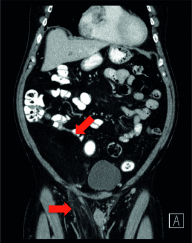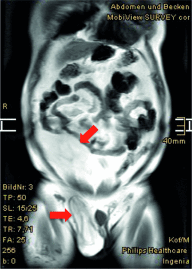Retroperitoneal Liposarcoma: A Concern in Inguinal Hernia Repair
- PMID: 30700965
- PMCID: PMC6345196
- DOI: 10.4293/JSLS.2018.00064
Retroperitoneal Liposarcoma: A Concern in Inguinal Hernia Repair
Abstract
Background and objectives: The goal of the study was to evaluate retroperitoneal sarcomas with continuous growth into the scrotum through the inguinal canal with regard to diagnostic approach, surgical treatment, and outcome. The analysis is based on a comprehensively documented case and a complete systematic review of published literature. Potential pitfalls are highlighted.
Methods: We describe the case of a 57-year-old male Caucasian who presented with a swelling in the right groin. Suspecting a scrotal hernia, transabdominal preperitoneal plasty surgery was planned but intraoperatively a large retroperitoneal mass was revealed. After computed tomography scan and magnetic resonance imaging, a complete resection of the tumor was performed. Ten previously published cases describing the same pathology were retrieved from the PubMed database and analyzed systematically in a complete literature review.
Results: Histology showed a well-differentiated liposarcoma with tumor-free resection margins. Twenty-two months postoperatively, the patient is in complete clinical remission.
Conclusion: Preoperative clinical suspicion of retroperitoneal involvement is paramount for developing of a surgical strategy and in unclear cases demands extended preoperative diagnostic workup. Following the appropriate patient management is crucial to prognosis.
Keywords: Hernia; Inguinal; Retroperitoneum; Sarcoma; Transabdominal preperitoneal plasty.
Conflict of interest statement
Conflicts of Interest: All authors declare no conflict of interest regarding the publication of this article.
Figures





References
-
- Mettlin C, Priore R, Rao U, Gamble D, Lane W, Murphy P. Results of the national soft-tissue sarcoma registry. J Surg Oncol. 1982;19(4):224–227. - PubMed
-
- Fletcher CD. The evolving classification of soft tissue tumours—An update based on the new 2013 WHO classification. Histophathology. 2014;64(1):2–11. - PubMed
-
- Milic DJ, Rajkovic MM, Pejcic VD. Primary omental liposarcoma presenting as an incarcerated inguinal hernia. Hernia. 2005;9(1):88–89. - PubMed
-
- Trans-Atlantic RPS Working Group. Management of primary retroperitoneal sarcoma (RPS) in the adult: A consensus approach from the Trans-Atlantic RPS Working Group. Ann Surg Oncol. 2015;22(1):256–263. - PubMed
-
- Longbotham JH, Joyce RP. Retroperitoneal liposarcoma presenting as spermatic cord tumor. Urology. 1987;30(3):276–280. - PubMed
Publication types
MeSH terms
Supplementary concepts
LinkOut - more resources
Full Text Sources
